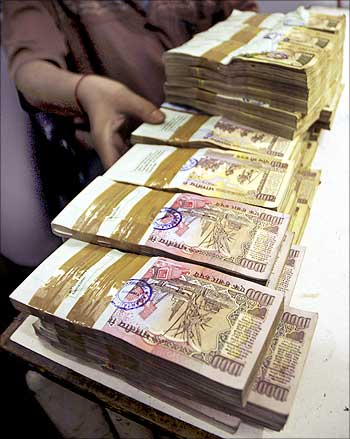Rajeev Srinivasan looks at the reasons behind the debacle.
The currency exchange rate is a representation of the market sentiment about the strength of a nation's economy. As such, it is often ruthless in indicating what the rest of the world thinks about a country's economic stewardship.
Thus, when the rupee plummets, it is a clear indication that the world thinks India's economy is in bad shape, and that its prospects for the future is cloudy.
The proximate cause is the Budget, with its Black-Swan event of a 50-year rollback and retroactive taxation of deals. This strengthens the notion that India is still a Banana Republic.
There is also the spectre of a balance-of-payments crisis as in 1991, which also followed a spending binge. India has a healthy foreign exchange reserve of some $330 billion, but this is not as much of a cushion as one might think: It may only pay for some months worth of imports.
What is also striking are the following numbers from Shankar Acharya in Business Standard ('The Exchange rate: Economics bites back): after being at around 1 per cent since 1991, the current account deficit is ballooning to about 4 per cent of GDP now; the fiscal deficit is stubbornly high at over 8 per cent.
According to The Economist, inflation was at 9.5 per cent in March, exceeded only by Turkey, Pakistan and Venezuela! And yet, here is the Government of India acting as though its finances were in the pink of health, proposing more entitlement programmes!
Tellingly, the interest rates on 10-year government bonds, at 8.51 per cent, are also among the highest in the world, exceeded only by Turkey, Pakistan, and everybody's favorite, Greece. Nice company.
From a personal point of view, a collapse in the rupee's purchasing power is a rude shock when an Indian travels outside the country. For instance, I remember traveling once to Thailand about twenty years ago. The Thai baht and the Indian rupee were roughly equivalent, and if I remember right, at about 20 to 25 to the dollar. So it was easy to compare prices -- including those of Bangkok's infamous and dodgy delights -- because you could just use relevant Indian prices.
Unfortunately, things have diverged a long way: the Thai baht (despite the punishment of the Asian financial crisis a while ago) is still around 31.1 to the US dollar, whereas the rupee has plunged to (as of this writing) 56 to the US dollar (56.38 this morning). That is, it has depreciated by about 80 per cent compared to the Thai baht.
What that suggests is that Thailand's economic fundamentals are considerably worse than those of Thailand. Thailand is a small country, with not much by way of natural resources or human resources, yet they are so much more economically worthy than India!
The saga of the rupee is starkly visible in this chart from The Economist (The Tale That Wags the Elephant, May 12, 2012) -- the rupee has continuously depreciated against the dollar. The sharp fall happened in 1991 as part of liberalisation, but the general trend has been downwards, except for two brief periods: One in the 2000-2007 era when the fruits of liberalisation were beginning to appear; and two in the 2008-2011 era when the financial meltdown hit the West.

In fact, that latter point is one of the two reasons why India is at risk now. There is an empirical observation that those countries that escape a particular financial crisis (and pat themselves on the back) are quite likely to fall prey to the next financial crisis.
There was an orgy of self-congratulation and complacency about the wisdom of the Indian 'third way' when the West self-destructed and India did not. That chicken may now be coming home to roost.
The second reason is structural: The Congress is happy with a certain economic climate; and if presented with any other, they will quickly convert it into what they like.
Some commentators have anointed the Congress 'the natural party of governance', and their 'natural form of governance' is: The Nehruvian Growth Rate of 2 to 3 per cent, high inflation, industrial stagnation, the license-permit raj, hyper-Keynesian tax-and-spend, crony capitalism, deficit financing, mushrooming public spending on entitlements.
I proposed a 'Goat Theory of Everything' to explain this phenomenon (see my earlier Rediff column). Much as goats will convert any lush grassland into their natural habitat of semi-arid, hardscrabble land, the Congress is structurally incapable of feeling comfortable in anything other than their natural habitat.
Part II: Rescuing the rupee: What can be done
You can read more columns by Rajeev Srinivasan here.











 © 2025
© 2025